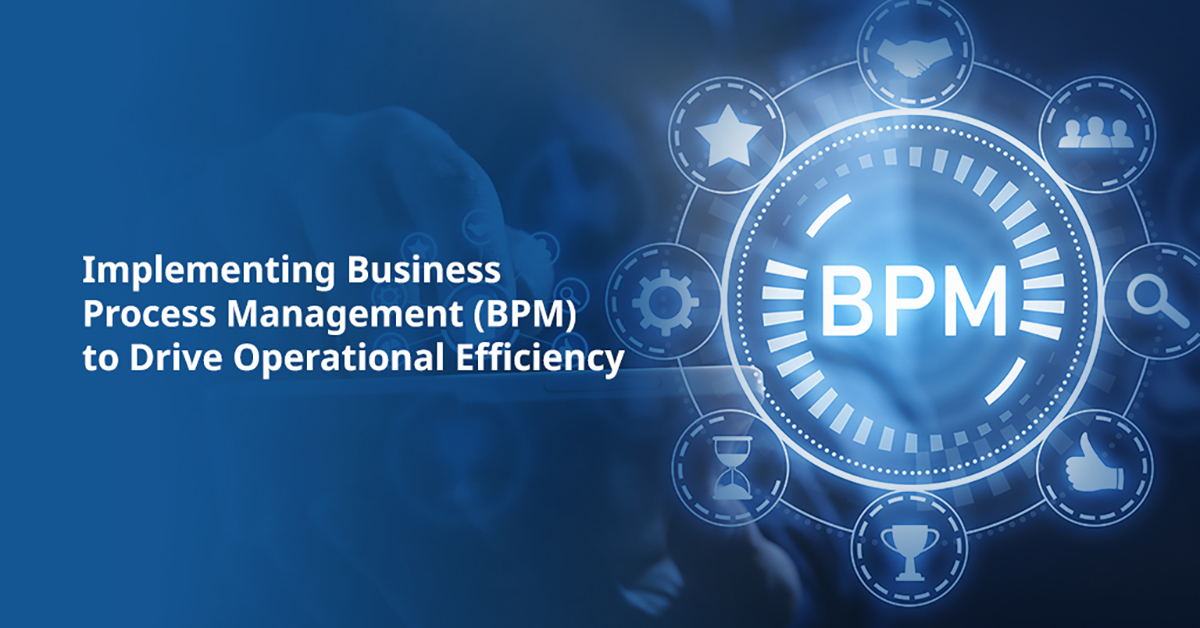Implementing Business Process Management (BPM) to Drive Operational Efficiency

Business Process Management (BPM) is a strategic approach that, when implemented, helps organizations optimize business processes and increase operational efficiency. BPM encompasses various key components, including process mapping, automation, and continuous improvement to achieve better business outcomes.
Steps to Implement BPM to Increase Operational Efficiency
#1. Analyzing Current Operations and Processes: A thorough analysis of existing processes can help more accurately identify inefficiencies. Steps can then be taken to address these inefficiencies, including engaging with employees, customers, and other stakeholders of the organization. This can help further outline bottlenecks and pain points in the operations and ways to improve efficiency.
#2. Process Mapping: Process mapping includes creating a detailed visual representation of operational workflows within the organization. Technology, in the form of tools or software, can be used to document activities, decision points, inputs, outputs, and participants involved in each process.
#3. Identifying and Implementing Automation Opportunities: Identifying tasks to be automated can help reduce the workload of existing manpower resources while helping improve overall efficiency. Automation technology also empowers organizations to cut down on delivery speed without negatively impacting quality.
Implementation of automation also includes integration with existing systems and processes. Thorough testing and validation can help minimize the risk of disruption during implementation.
#4. Designing Workflows: Based on process maps and automation, optimized workflows that are aligned with organizational goals and strategic objectives can be designed. This helps ensure workflows that are efficient, logical, and match requirements.
#5. Constant Improvement: A culture of continuous improvement fosters an environment of learning and innovation. Other measurable benefits include better alignment with future goals as the organization stays aligned with current and emerging technology and implements this technology optimally. It also helps boost employee engagement and adaptability as accountability increases.
#6. Monitoring Performance: Implementing key performance indicators (KPIs) to monitor the performance of both existing processes and any newly implemented ones can help further optimize efforts. Tracking metrics like cost savings, production cycles, error rates, and customer satisfaction rates can help review the efficiency of BPM initiatives.

Challenges of Implementing BPM and How to Overcome Them
#1. Resistance to Change
Resistance to change can often take the form of employees pushing back against new processes and technologies. Examples of effective ways to address this challenge include involving employees in the BPM implementation process from the beginning, inviting them to voice their concerns, and providing adequate training and support to address these concerns.
#2. Inadequate Leadership Support
BPM initiatives can flounder without strong leadership backing them. If these initiatives are launched, inadequate support can curb their momentum. Engaging executives and stakeholders from the beginning can help. It can also emphasize the benefits of BPM in driving operational efficiency and its role in business success.
#3. Complexity of Processes
Breaking down complex processes into more manageable steps can help prioritize improvements significantly.
#4. Data Integration Challenges
Integration of data from various systems can be challenging. However, with the help of robust integration tools and platforms, seamless data flow can be achieved between systems.
Choose to partner with experts, especially in automation and IT, to help ensure flawless automation and data integration. Expert insights can help enhance operational efficiency and add value.
The Advantage of Expertise
- Implementation of BPM helps organizations drive operational efficiency, optimize processes, and foster a culture of continuous improvement, leading to improved overall business performance.
- Partnering with BPM experts or consultants can guide the implementation process and provide insights on best practices.
- Expertise in workflow process management, business process automation, and even business process improvement can help organizations better optimize their current resources and infrastructure.
- Experts can also help organizations establish clear and measurable KPIs to evaluate the success of BPM initiatives. Regular and periodic reviews can help map progress and adjust strategies as needed to achieve desired outcomes.
At Analytix, we believe in continuous and consistent improvement, including when providing strategic business consulting services. This includes customizing solutions to your unique business needs. Our focus within business transformation services includes ensuring comprehensive communication, understanding expectations and requirements, and designing solutions for change management to ensure 100% efficacy.





.svg)


.svg)

